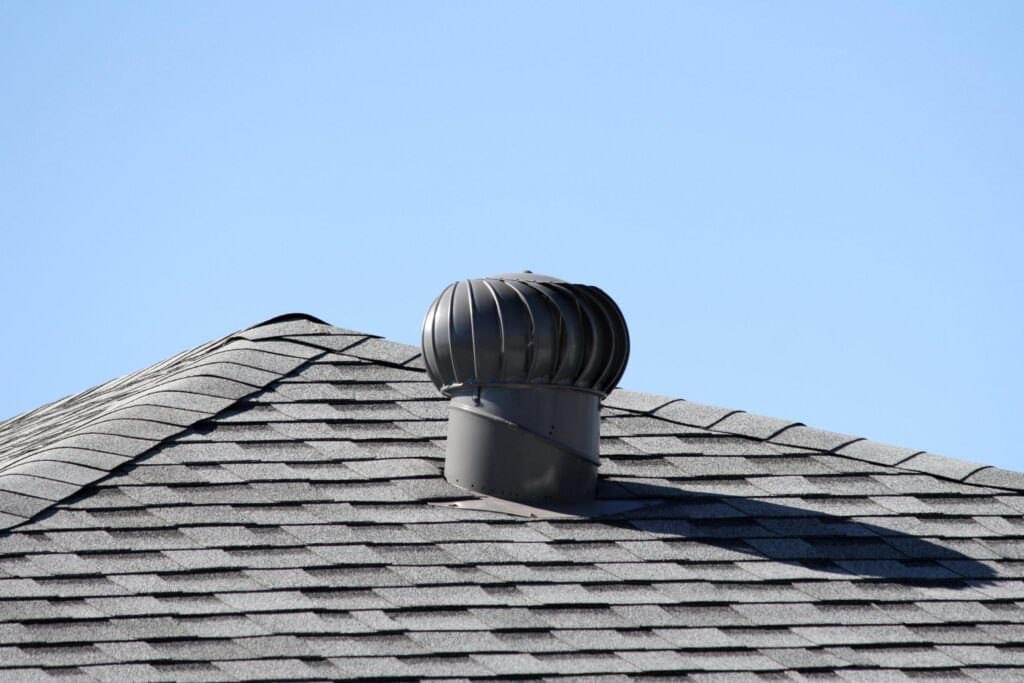Active Ventilation vs. Passive Ventilation (How to Choose)
Roof ventilation serves a crucial purpose. It allows air to flow through your attic, keeping the heat and humidity at bay.
When you have adequate roof ventilation, you are ensuring the longevity of your roof because who wants to pay for a roof replacement twice when you can maintain your roof with proper ventilation.
However, it’s not just as simple as installing some vents and the top and bottom of your roof. There are two main types of ventilation: active and passive. Each comes with different benefits and disadvantages that you should know about before investing in them.
If you’re here, that means you’re not a roofing or ventilation expert, and that’s okay! Rescue My Roof has spent the last ten years educating people just like you and giving them the information they need to make good decisions for their homes.
We are extending that same information to you, regardless of whether or not we are the roofing contractor for you. All we want is for you to have a pain-free roofing experience with incredible results.
In this article, we will be covering the ins and outs of active and passive ventilation. And by the end, you will have a better idea of which venting system is best for your home.
What is Active Ventilation?
Active ventilation uses a motor, fan blade, or a turbine to aid the airflow in an attic space.
Think of an active vent as a fan. The blades spin and air underneath them is sucked out and pushed outside of your home.
Then intake vents use their blades to help move fresh air into the attic, keeping up with the ideal air circulation.
This type of ventilation will replace the air inside the attic with fresh air from outside faster than passive ventilation due to more consistent airflow.
Different Types of Active Ventilation
There isn’t just one type of active ventilation – there are many! Here are the four types of active vents you should know about:
1. Turbine Vents

Turbine vents work by using convection.
Convection is the act of hotter, less dense material, like warm air, to rise. Convection is what causes the hot air to rise to the top of your attic, where the turbine vents spin, creating a fan that sucks the hot air out of your attic.
This type of ventilation moves the air around in your attic approximately 10-12 times per hour.
2. Power Vents
Power vents are circular-shaped vents that are installed near the top of your roof. They use electricity to pull the hot air out of your attic.
However, during the winter, power vents require a humidistat, an electronic device that tells you how much humidity is in your attic space.
If you run power vents without a humidistat, the humidity will build up in your attic and may lead to mold growth and rotten decking.
So if this type of ventilation is for you, make sure you invest in both to protect your roof.
3. Solar Powered Vents
Solar-powered vents are similar to power vents. However, instead of electricity, they use the sun as their power source.
While this is a great energy saver, there is a catch. The solar-powered battery needs to charge, and during that time, the vent turns off.
Additionally, the battery doesn’t hold a charge long enough for the vent to run all day. This may result in you turning on your home’s air conditioner, and your energy bill may go up.
4. Ridge Vents
Ridge vents are out into the ridge (top) of your roof and run the entire roof’s length.
This ventilation style is not noticeable from the ground, which is a benefit for those who don’t want to see the ventilation on their roof.
A downside is that this vent has a filter, but it is not perfect. You may have to deal with insects and rain entering the attic space.
The Benefits of Active Ventilation
The design of active ventilation and its use of a motor or turbines gives it two benefits:
1. Effective Regardless of Weather Conditions
If there is little or no wind happening outside, passive ventilation does not work as effectively as it usually should.
Active ventilation does not have that problem. As it uses an energy force to keep its motor going, it does not need to rely on external forces to cool your home.
So regardless of the weather conditions, this system will function optimally all of the time.
2. Effective At Venting Complex Structures
Does your roof have a unique design? Lots of corners and valleys that make your attic into a special layout?
When your attic has a lot of nooks and crannies, it can be challenging to ensure that no heat or moisture is getting trapped in the attic and causing mold growth or wood rotting.
With passive ventilation, keeping your attic dry can be difficult. As active ventilation has more power, it is highly recommended if you have a unique roofline.
Active Ventilation Disadvantages
Not everything can be perfect, including active ventilation. Here are a few downsides you should know before making a decision:
1. Active Ventilation Uses Energy
If you install an active ventilation system for the first time, you may see a slight increase in your home’s energy bill.
This type of ventilation needs a power source to function. So if you want to keep your energy bill as low as possible, this may not be the best system for you.
However, the decision to purchase should be dependent on factors other than price. Don’t let a slight increase in your bills deter you if a professional recommends this system for your home.
Investing in this system can save you from the costly repairs that could occur down the road if you do not have proper ventilation.
2. Active Ventilation Will Experience Wear and Tear
Active ventilation uses moving parts, which means it will experience some degree of wear and tear over time.
You should inspect your vents once a year to make sure everything is functioning normally. If you detect any issues, call in a professional to do a formal inspection.
By doing this maintenance, you are maximizing your ventilations lifespan and keeping your roof safe.
What is Passive Ventilation?
You’ve probably seen passive vents before, as they are the most common in the roofing industry.
Unlike active vents, passive vents don’t use a motor, fan blades, or a turbine. They only rely on the natural airflow through the space to keep air circulating in your attic.
This means that the amount of air flowing through your attic is dependent on the attic’s temperature, moisture content of the air, wind speed, roof pitch, and roof height.
3 Types of Passive Ventilation
1. Static Vents
Have you ever seen a roof that looks like it has an overturned box on the top?
Those “boxes” are actually static vents. They allow the heat to escape from your attic using convection.
As the heat in your attic rises, they are pushed out through these vents.
2. Ridge Vents
Ridge vents can both be active and passive, depending on the features. If they do not have baffles, the chutes that provide a channel for airflow, then they are passive vents.
The look of ridge vents is still the same. They will be a flat vent that runs the entire length of your roof.
3. Gable End Vents
Gable end vents are unique, as they are wooden, plastic, or metals vents that are put into your attic where two slopes of your roof meet.
This vent allows the wind coming from the outside of your roof to move the air in and out of your attic.
The Advantages of Passive Ventilation
Passive ventilation has some benefits over active ventilation, including:
1. Using Natural Forces to Cool Your Home
Not using an energy source to cool your home and encourage air circulation is a great way to see some savings on your energy bill.
Additionally, having a sound ventilation system eases the strain on your home heating and cooling systems, so you will see savings with that as well as long as your ventilation system is up to par.
2. Passive Ventilation Does not Use Fossil Fuels
Want to play a role in saving our planet? Then this is a major plus of passive ventilation systems.
These ventilation systems don’t use fossil fuels to power them, meaning they are a “green” system. If you are concerned about the use of fossil fuels, then this type of system may be the best for you.
3. Needs Little Maintenance
With passive ventilation, there is minimal upkeep.
The only thing that you are encouraged to do every year is to make sure nothing is blocking the vents so they can continue to perform well.
Things like dust, insulation, and other debris can block the vents and allow moisture to accumulate in your attic space.
This can lead to issues like mold and mildew, so check your vents annually.
The Disadvantages of Passive Ventilation
As passive ventilation relies so much on other factors like your roof pitch, height, and temperature, there are some situations where it won’t be ideal to have passive ventilation.
These situations can include:
- Not enough space on your roof for the adequate amount of vents (at least one foot of passive ventilation for every 300 square feet of attic floor space)
- Complex roof structure
- Low pitched roofs
Any aspects of your roof that make it possible for heat and moisture to accumulate, like cavities, corners, and spaces, put your home at risk for mold and mildew growing in the attic space. Passive ventilation may not conduct airflow enough to keep the moisture out of these places, meaning they are not a good fit for your home.
Unless you have a very simple roof layout without a lot of nooks and crannies, talk with your roof inspector to discuss whether or not passive or active ventilation is best for your home.
How To Choose Which Ventilation Type Is Best For You
Now that you are equipped with all of the knowledge you need to know about active and passive ventilation, the next step is choosing the right system for you.
Here are some things you should take into consideration:
- The Style of your Home
- The weather in your area
- Your budget
- Energy bill increases
- The amount of upkeep
If you aren’t interested in things like upkeep, or you don’t want to invest a ton of money into a ventilation system, passive ventilation may be the right match for you.
If you don’t mind upkeep, increased energy bills, and have a little more room to spare in your budget, active ventilation may be more efficient for your home.
You can learn more about the importance of proper roof ventilation with “5 Reasons Why Proper Roof Ventilation is Important.”
If you want a ventilation upgrade, Rescue My Roof can offer you an estimate! Contact us today to schedule your free estimation appointment.

